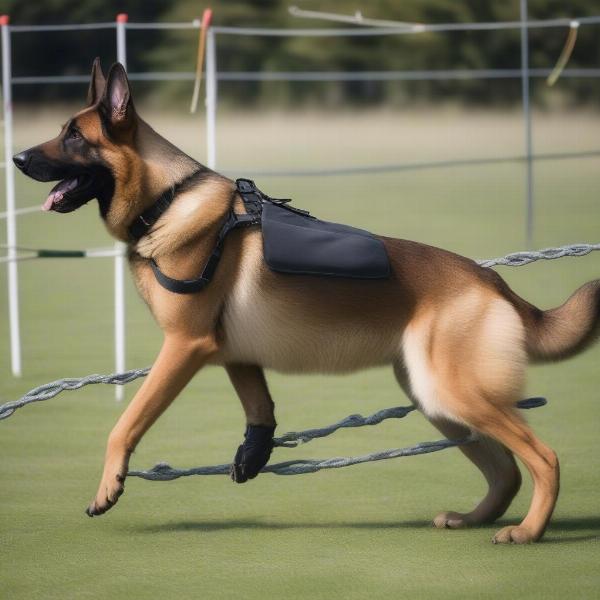Big dog K9 often evokes images of powerful working dogs, and rightfully so. But what exactly does the term “big dog K9” encompass? This article delves into the meaning of “big dog K9,” exploring its common uses, the types of dogs often associated with it, and the important considerations for those interested in these impressive canines.
Decoding “Big Dog K9”
The term “big dog K9” is a colloquialism, not a strict scientific classification. “K9” itself is a homophone for “canine,” often used to refer to police or military working dogs. Therefore, “big dog K9” generally refers to large breeds employed in these roles, or simply large dogs with the characteristics often associated with working dogs. These characteristics can include intelligence, trainability, strength, and a strong work ethic. Sometimes, the term is also used more loosely to describe any large dog breed, regardless of their training or intended purpose. Understanding the context is key to interpreting the meaning of “big dog K9.”
Common Big Dog K9 Breeds
Several large breeds are frequently associated with the term “big dog K9,” many of which excel in working roles. German Shepherds, Belgian Malinois, Rottweilers, and Doberman Pinschers are popular choices for police and military work due to their intelligence, trainability, and protective instincts. Other large breeds, such as Great Danes, Mastiffs, and Cane Corsos, might also be considered “big dog K9” types, even if they are less frequently used in professional working roles. Their size and presence alone can be a deterrent, and with proper training, they can make excellent guard dogs.
Owning a Big Dog K9: Key Considerations
Owning a “big dog K9” type comes with significant responsibilities. These dogs require ample space, both indoors and outdoors, to thrive. Their energetic nature necessitates regular exercise and mental stimulation. Training is paramount, especially for breeds with strong protective instincts. Early socialization and consistent obedience training are crucial for ensuring they become well-adjusted adult dogs. Potential owners should also consider the financial commitment involved in caring for a large breed, including food, veterinary care, and potential training expenses.
What Does Big Dog K9 Training Entail?
Training a “big dog K9” is a commitment that requires patience, consistency, and a deep understanding of canine behavior. Whether you’re aiming for basic obedience or specialized skills, starting early is crucial. Puppy classes provide a foundational understanding of basic commands and socialization. For those seeking advanced training, such as protection work or scent detection, working with a certified professional trainer is essential. These trainers can tailor a program to your dog’s specific breed and temperament.
 Big Dog K9 Training Exercises
Big Dog K9 Training Exercises
Conclusion
The term “big dog K9” encompasses a range of large, powerful breeds often associated with working roles. While their impressive size and capabilities can be alluring, potential owners must carefully consider the responsibilities involved. Proper training, socialization, exercise, and a significant time commitment are essential for ensuring the well-being of these magnificent animals. By understanding the nuances of the term “big dog K9” and the commitment it entails, prospective owners can make informed decisions and provide the best possible care for these extraordinary companions.
FAQ
- What does K9 mean? K9 is a homophone for “canine” and commonly refers to working dogs, especially in police or military contexts.
- What are some common big dog K9 breeds? German Shepherds, Belgian Malinois, Rottweilers, and Doberman Pinschers are often used as K9s.
- Is owning a big dog K9 right for me? Consider your lifestyle, space, and ability to provide training, exercise, and financial resources.
- Where can I find a qualified trainer for my big dog K9? Consult with your veterinarian or local kennel clubs for recommendations on certified professional trainers.
- Are big dog K9 breeds good with children? With proper socialization and training, many big dog K9 breeds can be loving family companions.
- How much exercise does a big dog K9 need? Big dog K9 breeds typically require significant daily exercise, both physical and mental.
- What are the legal responsibilities of owning a big dog K9? Be aware of local leash laws, licensing requirements, and any breed-specific regulations.
ILM Dog is a leading international website dedicated to providing expert advice and resources for dog owners worldwide. We cover a wide range of topics, from breed selection and healthcare to training, nutrition, and grooming. Whether you’re a seasoned dog owner or just starting your journey, ILM Dog is your trusted source for all things canine. Contact us at [email protected] or +44 20-3965-8624 for personalized advice or explore our comprehensive resources at ILM Dog.